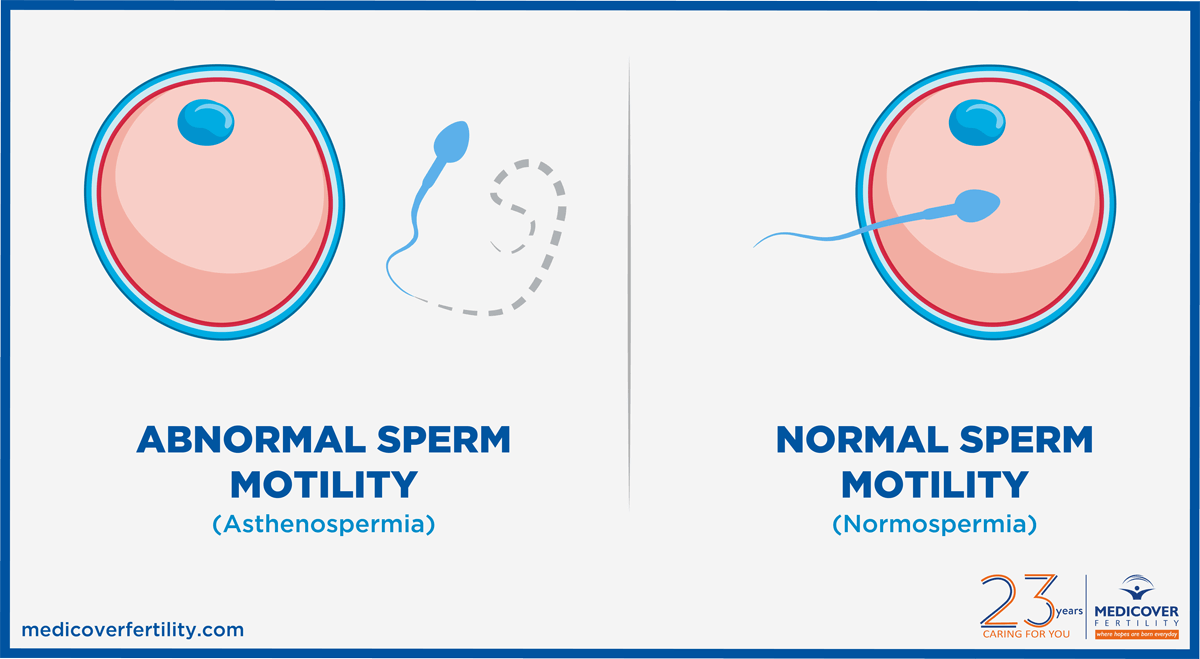Sperm motility
For fertilisation to happen, individual sperm needs to be able to move or ‘swim’ effectively so it can actually reach the egg. This movement is referred to as sperm motility. Read on to find out more about what sperm motility is, and how it affects male fertility. Plus, find out what happens if you or your partner have low sperm motility, what causes it, and what lifestyle changes can improve it.
What is sperm motility?
For sperm to fertilise an egg, it needs to move. Sperm moves in a wriggling, swimming motion, which helps it go through a woman’s cervix, uterus, and fallopian tube to reach the egg.
When we talk about sperm motility, we are referring to how well the individual sperm swims—essentially the movement and speed of the sperm cells.
A Basic Semen Analysis (BSA) measures the major factors of sperm health, like sperm count, sperm concentration, and sperm motility. The results of a sperm analysis can reveal what percentage of the sperm moves, and how. These are the different types of motility that you might see in a BSA analysis:
- Progressive motility. This type of motility refers to sperm that swim progressively, mostly in a straight line or in large circles.
- Non-progressive motility. This type of motility refers to sperm that are moving but not progressing forward, for example, this type of sperm does not travel in straight lines or may swim in tight circles.
- Total motility. This refers to the total number of sperm cells that are moving.
- Immotile sperm. These are the sperm cells that do not show any movement at all. It’s normal to have a small percentage of immotile sperm in a specimen. For a man to be fertile, he will need a total motility of at least 40%, and his sperm needs to have progressive motility of 32% or more1.
What causes low sperm motility (asthenozoospermia)?

The causes of low sperm motility—known in medical terms as asthenozoospermia or asthenospermia—are in many cases unexplained, but age and damage to the testicles can also be a reason. The testicles make sperm cells and store them, so any damage to them can affect sperm quality.
A study from 20212 also found that the risk for low sperm motility increased for men who:
- Work in manual work. Although the risk was found to be higher in men with increased exposure to glycol ethers (certain solvents) or other toxins, it’s unclear why the risk is increased for those doing other forms of manual work.
- Are not working. The study found unemployed men and students to be in a high risk group, although the reason is not readily explained.
- Have had testicular surgery. Men who have had testicular surgery are in a high-risk group for low sperm motility, but the reason for the risk is uncertain. One study from 20073, also says undescended testicles is the more likely cause of reduced fertility, one of the main reasons that men get testicular surgery, rather than the surgery itself.
- Wear tight underwear. Additional studies also support that men who wear loose underwear like boxer shorts are at lower risk of having low sperm motility, as this type of underwear can help keep the testicles cool.
- Are of black ethnicity. Although black men seemed to be at a slightly increased risk than men of other ethnicities for low sperm motility, the exact reason for this is still unknown.
How is low sperm motility diagnosed?
A routine semen analysis (BSA) can include a test for sperm motility. For this test, two semen samples are needed, usually obtained via masturbation at the doctor’s office or the testing facility.
It’s important that intercourse or masturbation does not take place in the 48 hours before the sample is collected, and that abstinence of sex or masturbation not be more than seven days.
If the sample is taken at home, it is recommended not to use a condom or lubricant while collecting the sample, and it’s important to keep the sample warm—close to body temperature—otherwise sperm won’t survive. Deliver the sample to the testing facility or doctor’s office as soon as possible, as testing must take place within an hour of ejaculation.
When total motility is below 40%, this is considered low sperm motility.
How does low sperm motility affect fertility?
Although 90% of male infertility is caused by low sperm count, poor sperm motility is an important factor.
Low sperm motility is another cause of male infertility. Getting pregnant with low sperm motility can be difficult, as having sperm that cannot swim to the egg means the egg cannot be fertilised.
How to improve sperm motility with lifestyle changes
If you or your partner are diagnosed with low sperm motility, it’s best you talk to your doctor, as there may be an underlying medical condition like varicocele (when veins inside the scrotum become enlarged).
If an underlying medical issue is the cause, treatment will be very specific to your case.
There are, however, some lifestyle changes you can make that may help increase overall sperm and fertility health, including:
- keeping the testicles cool with loose underwear
- getting regular exercise
- maintaining a healthy weight
- reducing alcohol consumption
- quitting smoking
- managing stress
- talking to a doctor about any medications taken.
FAQs about sperm motility
-
What is the normal total motility of sperm?
According to the World Health Organization, the normal total motility of sperm is 40 to 81%3.
-
How can sperm motility be improved?
A healthy lifestyle can help with overall sperm health, so, for example, quit smoking and reduce your alcohol intake, but if you have low sperm motility talk to a doctor because the treatment they recommend will be very specific to one’s personal situation.
-
Is 70% sperm motility good?
Yes, sperm motility above 40%—which means that 40% of a man’s sperm is motile—is considered normal.
-
Can conception happen without motile sperm?
No, motile sperm is needed for a sperm to be able to reach and fertilise the egg.
-
How can pregnancy happen with low motility?
Low sperm motility doesn’t mean a man has no motile sperm, for example 30% sperm motility means 30% of the sperm is motile, and only one is needed to fertilise the egg. Saying that, it may be harder to conceive with lower sperm motility because the chances are reduced, but it’s not impossible.
-
Can sperm motility be checked at home?
Home sperm check kits are available and may check sperm count or sperm count and motility. These kits, however, may not be available where you live. Please check locally for availability.
The bottom line
Sperm motility is an important factor to consider when talking about male fertility because having sperm that can swim forward to reach the egg is crucial for conception to take place. There are tests your doctor can order to assess your sperm motility.
Sperm motility of more than 40% is considered normal, and the higher the percentage the more sperm there are that can swim to meet the egg. Low sperm motility is when 40% or fewer sperm can swim forward to meet the egg. This does not mean conception is impossible, but it may be harder.
If you or your partner have low sperm motility, your doctor will be able to help diagnose the underlying cause and recommend the appropriate treatment, but a few lifestyle changes like giving up smoking or cutting down on alcohol could help with overall sperm health.
- 1. Cooper, T. G., et al. (2010). World Health Organization reference values for human semen characteristics. Human reproduction update, 16(3), 231-245. https://www.who.int/reproductivehealth/topics/infertility/cooper_et_al_hru.pdf
- 2. https://academic.oup.com/humrep/article/27/9/2799/624878
- 3. https://pubmed.ncbi.nlm.nih.gov/17462053/



